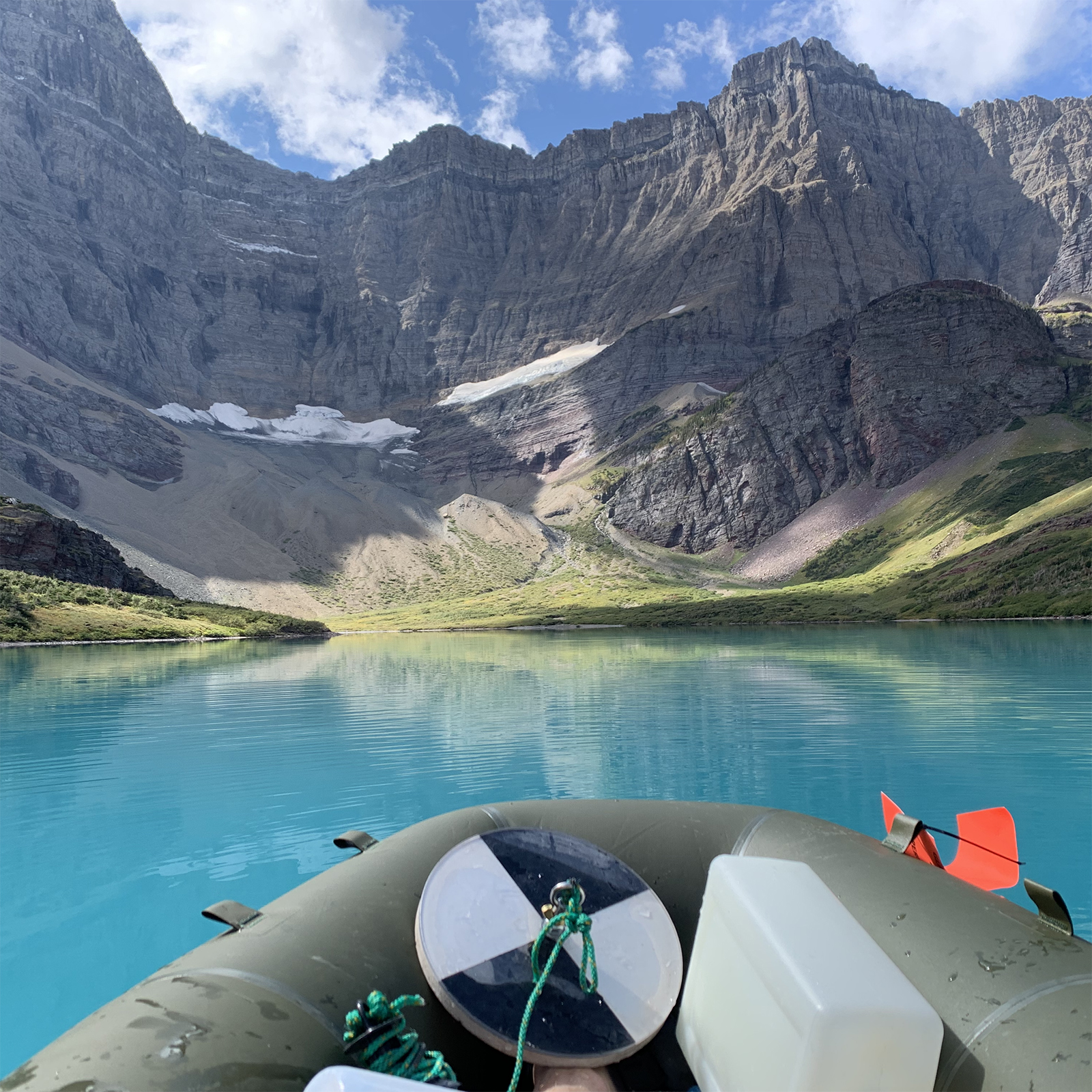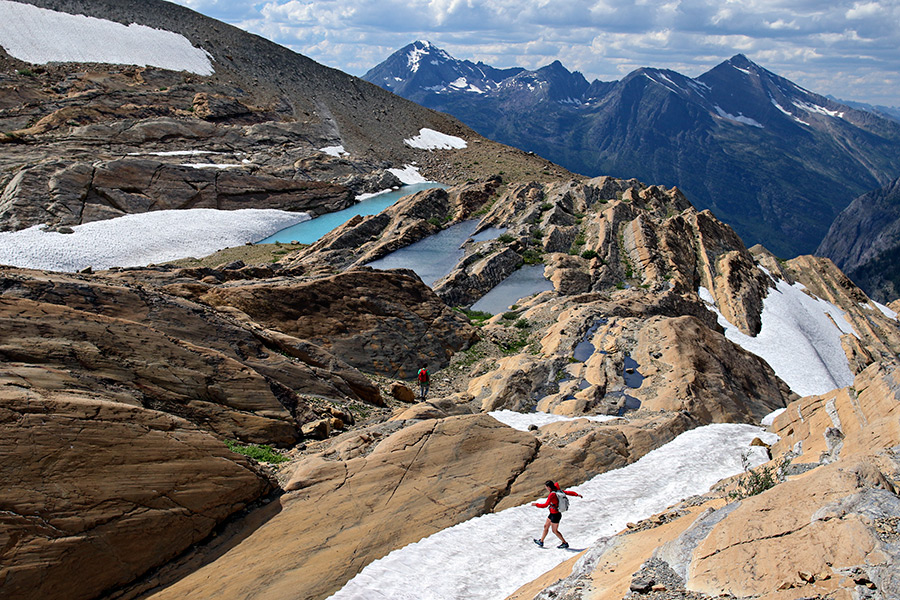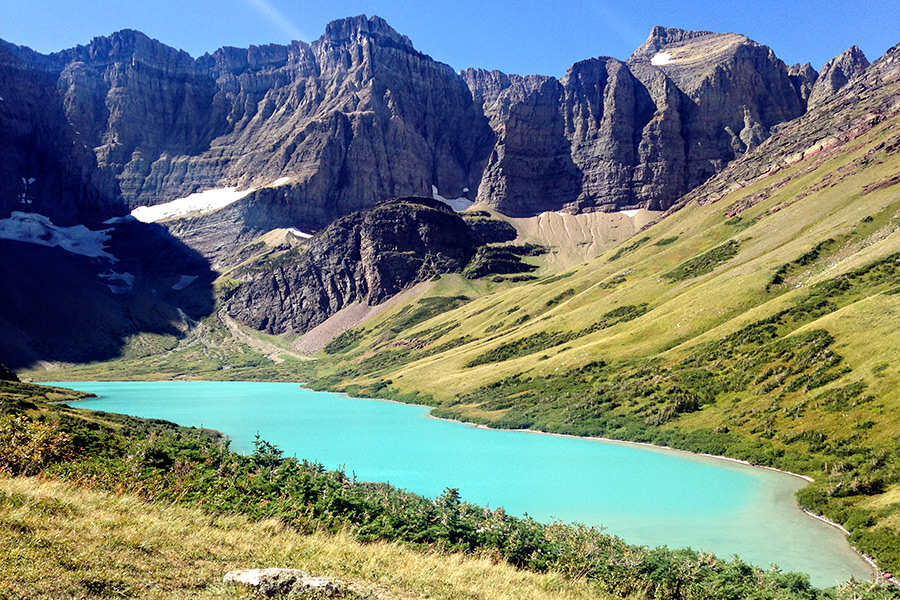The Mysterious Life of a Newborn Lake
As new alpine lakes form due to glacial recession in Glacier National Park, where climate warming is occurring two to three times faster than the global average rate, researchers are beginning to unpack the mysteries lurking beneath their surface
By Tristan Scott
As Glacier National Park’s namesake ice masses retreat, researchers are beginning to puzzle out the mysteries of the mineral-blue lakes bejeweling the remote alpine basins in their wake, where the Crown of the Continent’s melting snow and ice regulate the region’s water quantity and quality. And as these newborn lakes start to fledge in their ecological infancy — as colonies of planktonic crustaceans take up residency and complex food webs begin to form — scientists have realized that chronicling their early stages of development can provide a glimpse into the region’s past as well as its future.
In some cases, the new lakes haven’t been named, while in others they have never been studied, and the research represents pioneering science in the face of a warming climate.
“These are brand new lakes and no one really knows anything about them,” Jim Elser, the director of the University of Montana’s Flathead Lake Biological Station, said.
The lakes form in the bedrock and in scalloped depressions in the moraine. The glacial flour colors them a milky-white or turquoise-blue (imagine the Aqua Velva hue of a bottle of aftershave), and scientists are in the early stages of understanding the ecological consequences of how that turbidity helps or hinders photosynthesis and the creation of new life forms.
And with more than 40% of the world’s population tracing its water supply to mountain regions, where climate warming is occurring two to three times faster than the global average rate, causing extensive loss of glaciers and snowpack, a new study by a team of researchers based in and around Glacier National Park seeks to establish a baseline understanding of this transformation and its trickle-down effects. As these trends accelerate over the coming decades, scientists believe the changes may have implications for the biogeochemical and ecological characteristics of mountain ecosystems and the human services they provide.
For the scientists who helped conceive of the study, it’s also a perfect excuse to go hiking across some of the most dazzling alpine terrain on Earth.
“There is, of course, a broader significance to all this. But in the beginning, the concept was sort of frivolous,” Elser said. “I like backcountry adventures and mountains and hiking around, and this seemed like a good study to justify those activities.”

Indeed, due to the remoteness of many of the park’s glacially fed lakes, it’s not uncommon for Elser and his team of researchers to spend 16 hours or more hiking over rugged terrain to obtain a single sample of newborn lake water. That might be fun to a point, but even the most hardened mountain masochist has their limit.
So, what about the study’s broader significance?
“One reason we think this is important is that, in the Flathead, our watersheds start in the mountains — in the ice and the snow — and they’re processed through our lakes. That’s where our water starts to be acted upon by ecological processes. It’s important to know what the water is like before it starts its way down the watershed,” Elser explained. “The other part is theoretical. Most lakes in the world were born by glacial processes during the retreat of the continental ice sheets and, while there were people inhabiting those areas during that time period, there was no limnological sampling going on. Without the scientific technology to record data and observations, we don’t have any way of seeing what those lakes were like when they were first formed. The concept here was, we have the ability to observe these lakes in the first decades of their existence and put down that baseline understanding.”
For the first time, that baseline understanding has been documented in a research paper published by the Associations for the Science of Limnology and Oceanography. The study’s author is Joseph Vanderwall, a doctoral student at the University of Montana who keyed in on the significance of established high-alpine aquatic systems, and who is now preparing to defend his dissertation on aquatic secession in mountain lakes. To form the basis of the research, Vanderwall worked alongside Elser and U.S. Geological Survey (USGS) ecologist Clint Muhlfeld to identify glacially fed lakes and assemble six years’ worth of data in Glacier National Park, where Vanderwall deployed a packraft to collect water samples from the rarefied pools.
“This project was really sparked by Jim and I wanting to understand what’s happening in these lakes as they form,” Vandwerwall said. “This represents the blink of an eye in geologic time, and we don’t want to miss out on the opportunity to document their formation. And to do that, we’re really just posing some basic biology questions. What is living there? What are the primary producers? What is the base of the food web? How much biomass is there and what are the rates of photosynthesis?”

Those basic biology questions are yielding some profound results, including documenting for the first time that nitrate and phosphate levels are up to three times higher in glacially fed lakes, which contain generations’ worth of carbon emissions, than in non-glacial lakes, which are subject to seasonal snowmelt cycles.
The lake-sampling excursions have led Elser, Vanderwall and Muhlfeld into the high country of Glacier National Park, where the new silt-colored lakes are forming at the foot of Sperry Glacier, as well as Blackfoot, Jackson and Chaney glaciers. The researchers gathered samples from the newly formed waters at the base of the retreating glacier to determine whether food webs are beginning to form with the colonization of zooplankton.

“We saw a pretty large difference between snowpack-fed lakes and glacially fed lakes, which have higher concentrations of phosphorous and nitrogen,” Vanderwall said. “We recorded over two times the amount of phosphorous and nitrogen in glacial lakes. The hypothesis for why glaciers are shedding a lot of nitrogen and phosphorous is pretty obvious, in that there is a lot of nitrogen deposited into the lakes from the atmosphere, from fossil fuel burning deposited from rain or snow. Snowpack has that, too, but glaciers condense that over centuries.”
Glacier National Park is emblematic of the global retreat of glaciers. Of its 146 glaciers present at the end of the Little Ice Age (1300-1850), only 35% persisted through 2005, with complete deglaciation predicted by 2100.
“The lakes forming in this iconic place are ultimately at the top of our water tower flowing into the whole Columbia River basin, and at the park’s hyrdrological apex it’s also flowing into the Hudson Basin,” Vanderwall said. “So preserving the water quality and observing what’s happening in these top systems that are changing so rapidly is critical to preserving these resources for future generations, and if we can’t preserve them then at least we can monitor them in the future.”

But even though glacial recession could lead to new aquatic life systems as the lakes take hold, Muhlfeld says there are “hotspots of biodiversity” that thrive in glacial meltwater. Muhlfeld even helped pioneer a study that provided the first comprehensive evaluation of the current status, distribution and habitat requirements of two rare alpine insects found only in the glacial-fed streams — the western glacier stonefly and meltwater stonefly, which are in jeopardy of extinction.
“This study builds on decades of stream work looking at glacial loss and the consequences to downstream aquatic life,” Muhlfeld said. “This is the first study to look at these newborn, proglacial lakes. When glaciers recede they leave behind these bathtubs of water at the highest point in our watershed, so of course we want to understand the biological communities forming at the top of the continent. We already know there are distinct invertebrate cold-water communities that can only live in these glacial meltwater streams, and we may find similar patterns with newborn lakes.”
For Elser, the study is both a fascinating crystal ball into the future as well as a daunting specter of what the warming world will look like.
“In some ways, these are our first glimpses of these lakes, so it’s exciting in that regard,” Elser said. “But it’s also sort of the last glimpses of the remains of the cryosphere, which is quickly fading. People ought to be thinking about that and working to counteract. I like to think about it as the last ice cube in your drink. As the ice cube melts, the drink remains nice and cold. But as soon as that last piece of ice is gone, your drink gets really warm really fast. So, once we lose that cooling action it changes downstream temperature regimes, and that will be dramatic. We need to pay more attention to the frozen part of that cycle not just in the poles but in the mountain regions as well.”
On Wednesday, Oct. 18, at 6 p.m. at The Lodge on Whitefish Lake, members of the public can attend a free, informal presentation by Vanderwall. Billed as a “science quencher,” the event will feature free drinks and appetizers as part of the kickoff to the Whitefish Lake Institute’s Montana Lakes Conference taking place Thursday and Friday.